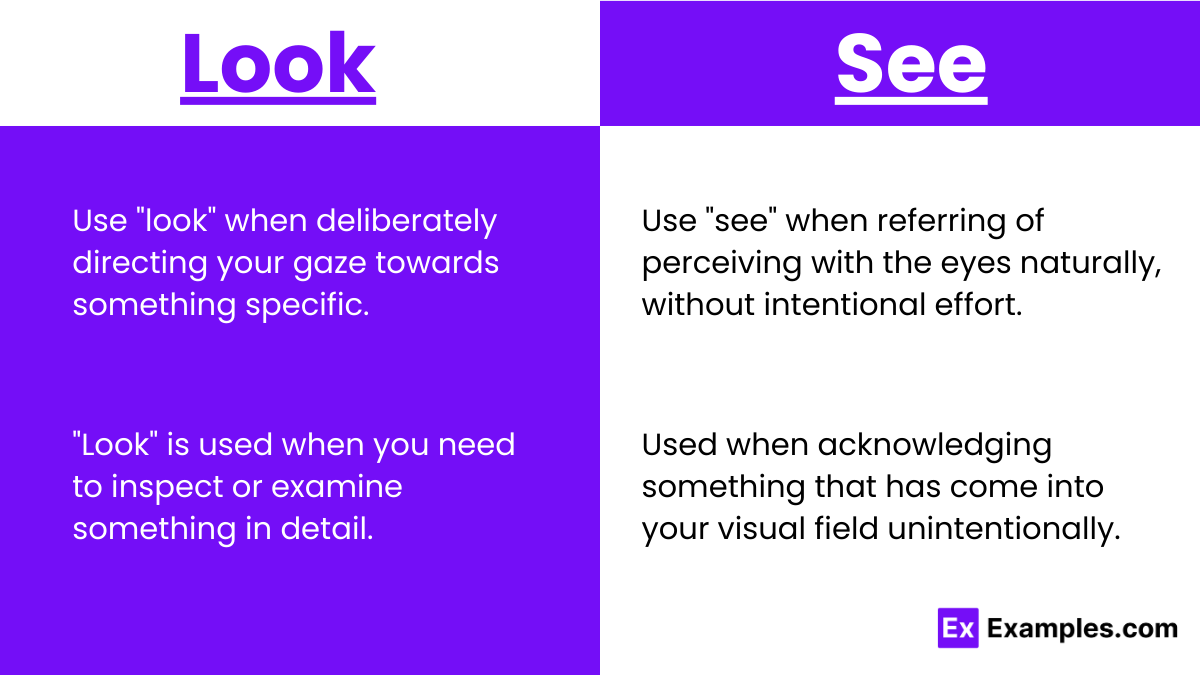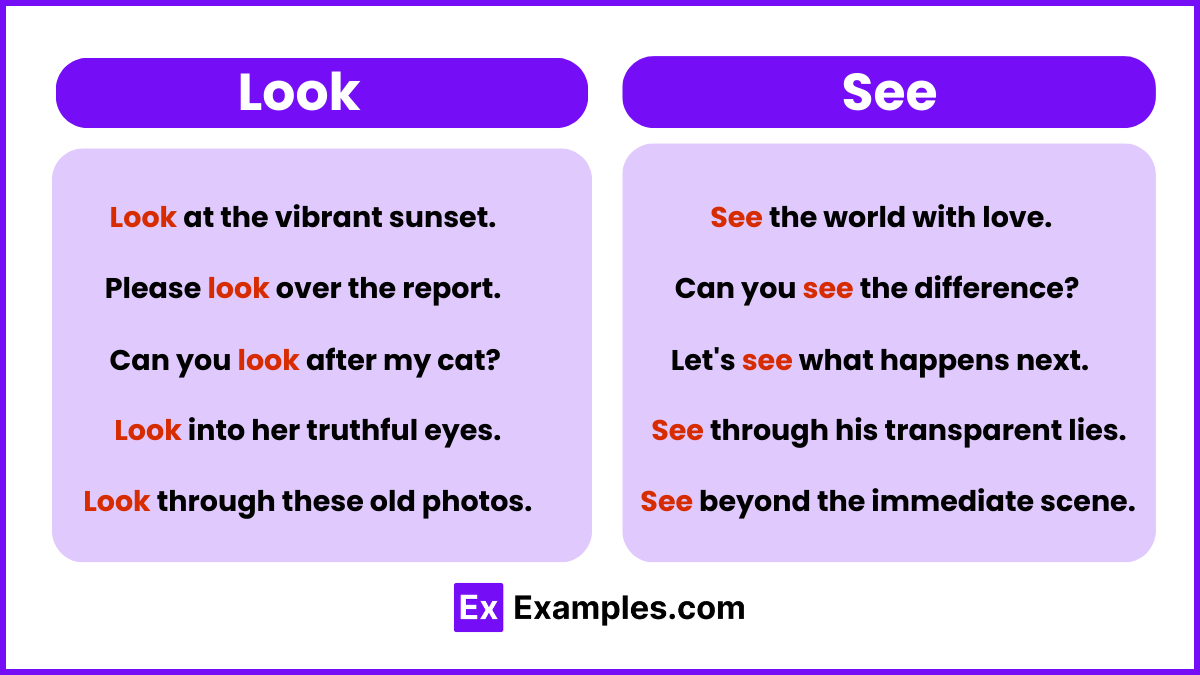Look vs See – Meanings, Difference, Examples, Usage
In everyday communication and literary expression, the verbs “look” and “see” play pivotal roles in describing the nuances of visual perception. Although they are often used interchangeably, a deeper understanding of their distinctions can significantly enrich one’s ability to convey precise observations and experiences. “Look” involves an element of intention and focus, directing one’s gaze towards something specific. In contrast, “see” describes the more passive process of receiving visual stimuli, often without deliberate effort. Recognizing these subtle differences enhances not only verbal and written communication but also our appreciation of the complex nature of seeing and looking.
Look and See – Meanings
- Look: This action refers to the intentional direction of one’s gaze towards something. It involves a conscious effort to focus the eyes on a particular object or area, suggesting an active engagement or an attempt to find or observe something.
- See: In contrast, “see” implies the passive reception of images by the eyes. It denotes the ability to perceive objects or light within one’s field of vision, often without deliberate intention. Seeing is a fundamental sensory process that happens automatically.
Summary
“Look” and “see” are two distinct terms related to our visual experience. “Look” involves actively directing our gaze towards something, implying a conscious effort to focus or search. It’s an intentional act, like when we look for a friend in a crowded room. On the other hand, “see” refers to the passive process of perceiving with our eyes, which happens automatically without conscious effort. We see whatever enters our visual field, like noticing the color of the sky. While “look” suggests deliberate observation, “see” is about involuntary visual reception, forming the foundation of our sensory experience.
How to Pronounce Look and See
- Look: Pronounced as /lʊk/, this one-syllable word has a clear, short “oo” sound, capturing the act of directing one’s gaze.
- See: Pronounced as /siː/, this one-syllable word features a long “ee” sound, reflecting the continuous nature of visual perception.
Differences between Look and See
| Aspect | Look | See |
|---|---|---|
| Definition | Intentional direction of gaze. | Passive reception of visual stimuli. |
| Conscious Effort | Requires conscious effort to focus or observe. | Occurs without deliberate intention; automatic. |
| Active vs Passive | Active process of searching or examining. | Passive process of visual perception. |
| Voluntary vs Involuntary | Voluntary action; can be controlled. | Involuntary; happens as long as eyes are open and functioning. |
| Purpose | Often for a specific purpose (to find, to examine). | General perception or accidental noticing. |
| Engagement | Implies engagement with the environment. | Implies mere awareness of surroundings. |
| Duration | Can be momentary or prolonged, based on intent. | Continuous as part of sensory experience. |
| Control | Subject has control over what to look at. | Subject sees whatever enters the visual field. |
How to Remember the Difference between Look and See
To remember the difference between “look” and “see,” think of a camera: “Look” is when you aim the camera intentionally, like choosing a subject to photograph. “See” is like the camera’s automatic mode, capturing images without any effort, simply because it’s turned on and facing the scene.
When to Use Look and See

Usage of Look
- Intentional Observation: Use “look” when deliberately directing your gaze towards something specific, like looking at a painting in a gallery.
- Searching for Something: Apply “look” when you’re trying to find something, such as looking for your keys.
- Requesting Attention: Use “look” when asking someone to direct their gaze towards something, like saying “Look at this!” to point out something interesting.
- Examining Closely: “Look” is used when you need to inspect or examine something in detail, like looking at a document for errors.
Usage of See
- Passive Perception: Use “see” when referring to the act of perceiving with the eyes naturally, without intentional effort, like seeing a bird fly by.
- Realizing or Understanding: Apply “see” in a figurative sense when someone realizes or understands something, as in “I see what you mean.”
- Experiencing Events: Use “see” when talking about attending or witnessing events, like seeing a play or a concert.
- Acknowledging: “See” is used when acknowledging something that has come into your visual field unintentionally, like seeing a friend in a crowd unexpectedly.
How to Use Look and See
Using Look
As a Verb:
- Action: “Look” is used when someone actively directs their gaze or attention to something. For example, “Please look at the board.”
- Imperative: Often used in commands or requests to draw attention. For example, “Look here!”
- With Prepositions: Commonly paired with prepositions like “at,” “for,” and “into” to specify the focus. For example, “Look into this matter.”
As a Noun (less common):
- Refers to the appearance or expression of something or someone. For example, “He had a determined look.”
Using See
As a Verb:
- Perception: “See” describes the act of perceiving with the eyes, without the necessity of deliberate focus. For example, “I can see the stars.”
- Understanding: Metaphorically, it can denote comprehension. For example, “I see your point.”
- Experiencing: Used to indicate attending or being present at an event. For example, “Did you see that movie?”
Look and See – Examples

Examples of Look
- “Look at the sky for shooting stars.”
- “He looked around the room nervously.”
- “We looked through the photos nostalgically.”
- “Let’s look into the problem and find a solution.”
- “Take a moment to look over your work before submitting.”
- “He gave me a worried look before leaving.”
Examples of See
- “I see a rainbow after the rain.”
- “She saw the error in her calculations.”
- “Did you see the latest movie?”
- “We’re going to see a play downtown tonight.”
- “I can’t see the sign from here; it’s too far.”
- “Let’s see if we can fix this issue together.”
Synonyms
| Term | Synonyms |
|---|---|
| Look | Gaze, peer, glance |
| See | View, observe, perceive |
Exercise
Fill in the blanks with either “look” or “see” to complete the sentences accurately.
- Can you _____ who’s at the door?
- I can’t _____ the sign from here.
- _____ at this painting; it’s beautiful!
- Did you _____ the lightning flash?
- Let’s _____ for shells on the beach.
Answers
- see
- see
- Look
- see
- look
FAQ’S
What is the difference between look and see?
Look involves intentional focus, while see is passive observation. Looking is active; seeing happens naturally.
Can I see or can I look?
Use can I look for seeking permission to actively examine, and can I see for passive observation.
What is the difference between look and appear?
Look refers to the act of observing, while appear describes how something is visually perceived by others.
What is the difference between see and seeing?
See is the basic act of perceiving visually, while seeing often implies a deeper, continuous process of observation.
When should I say I see?
Say I see to acknowledge understanding or when you visually perceive something clearly.


